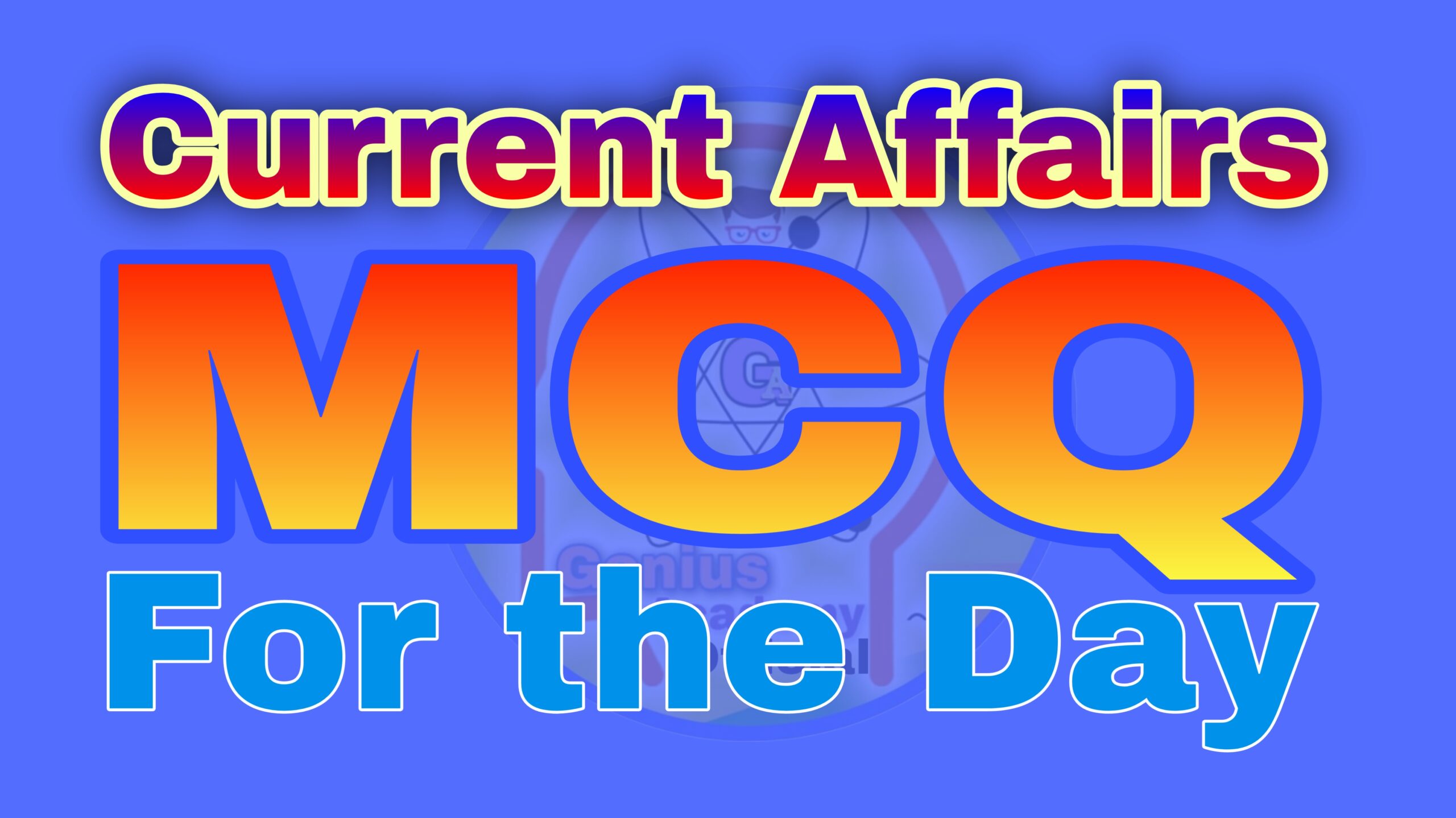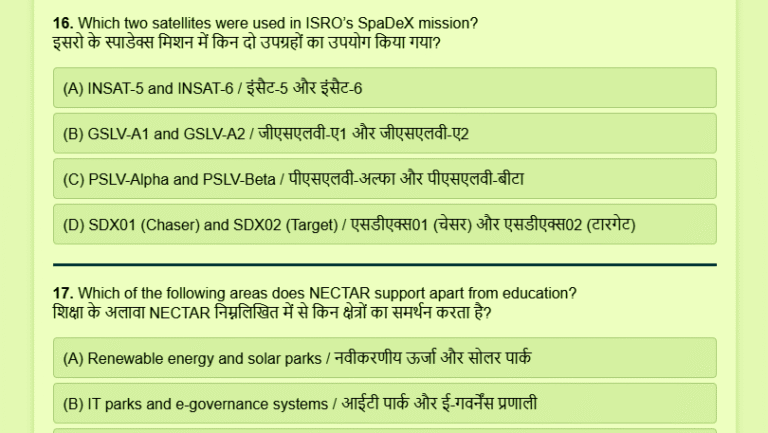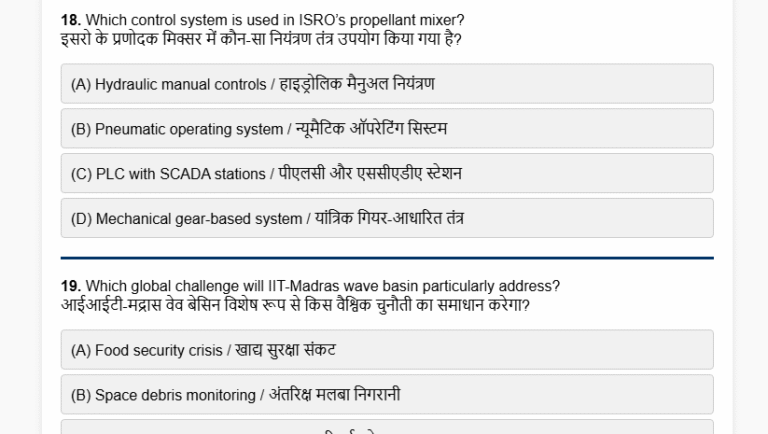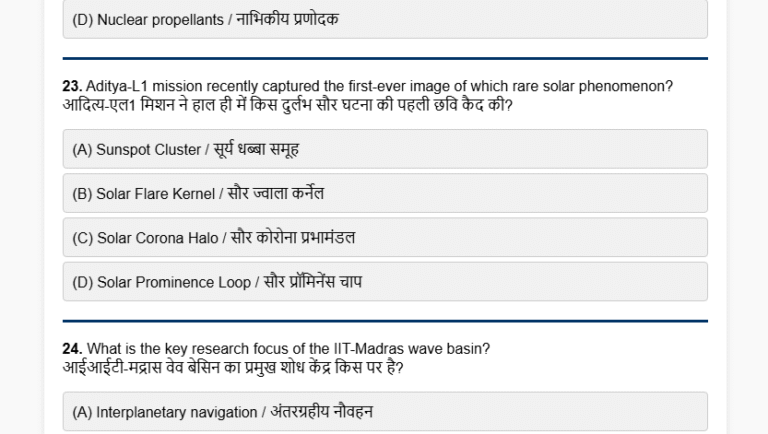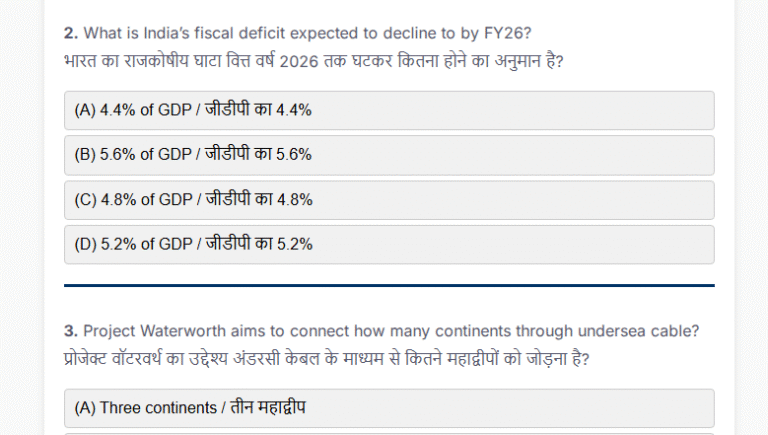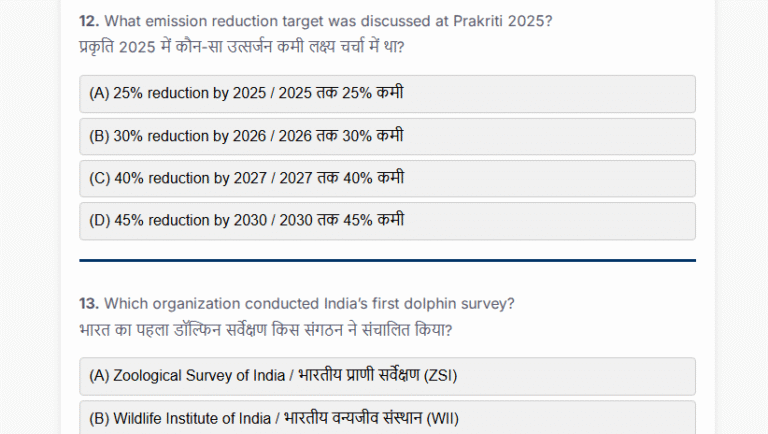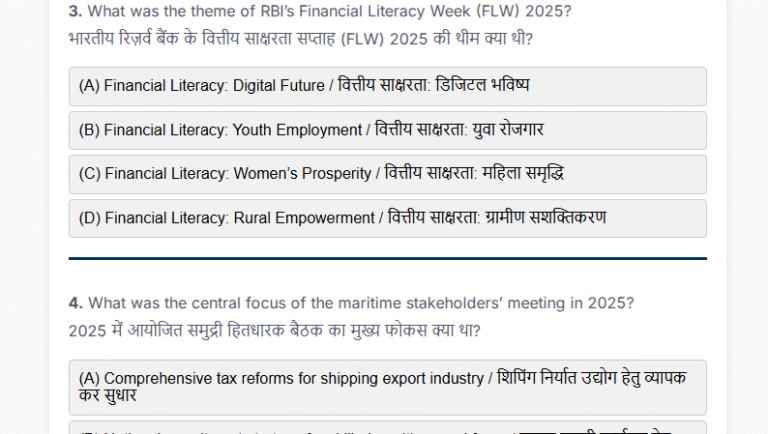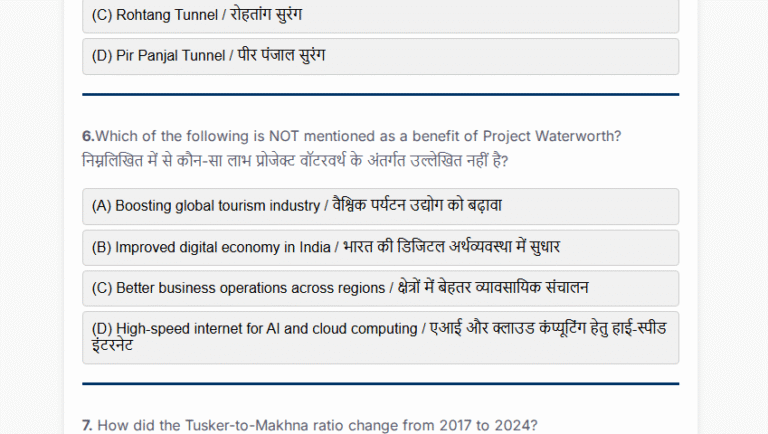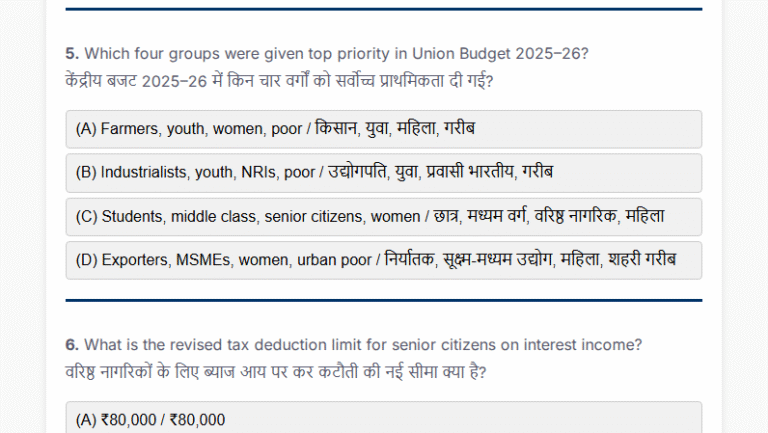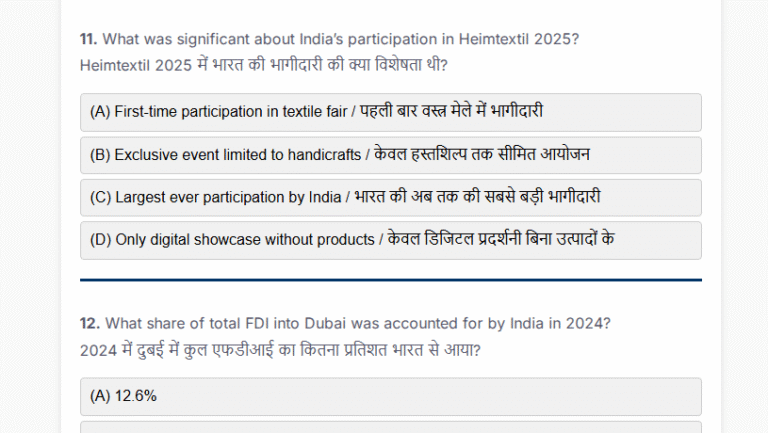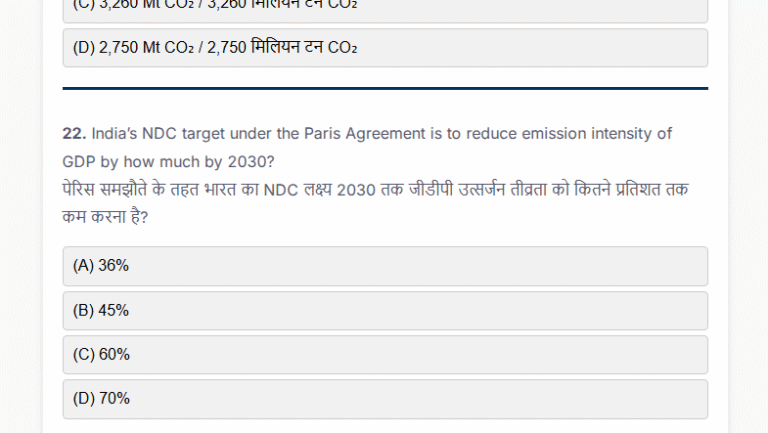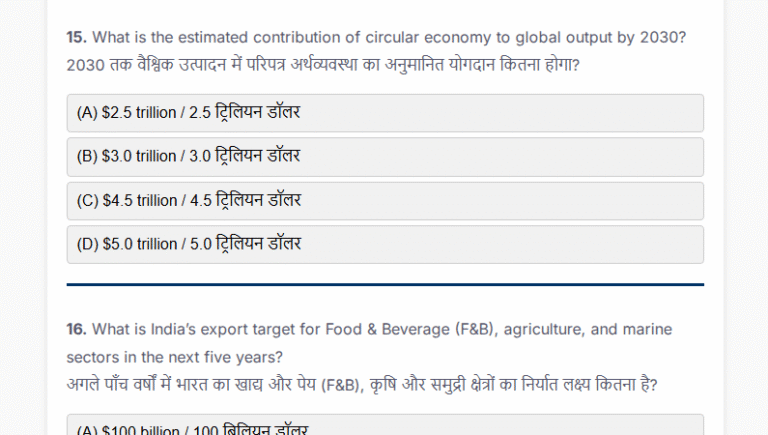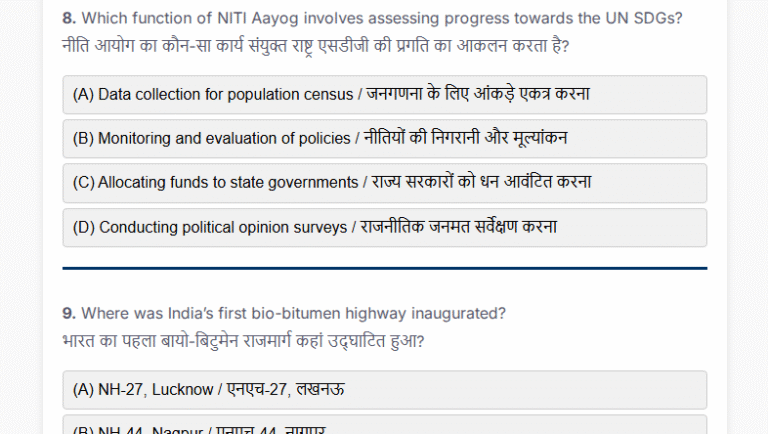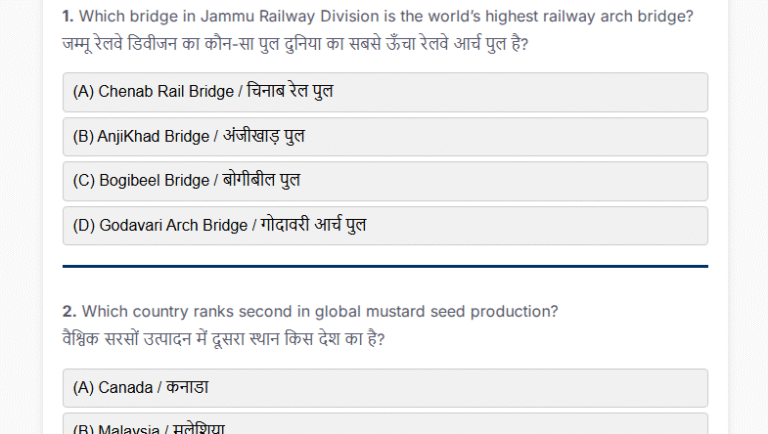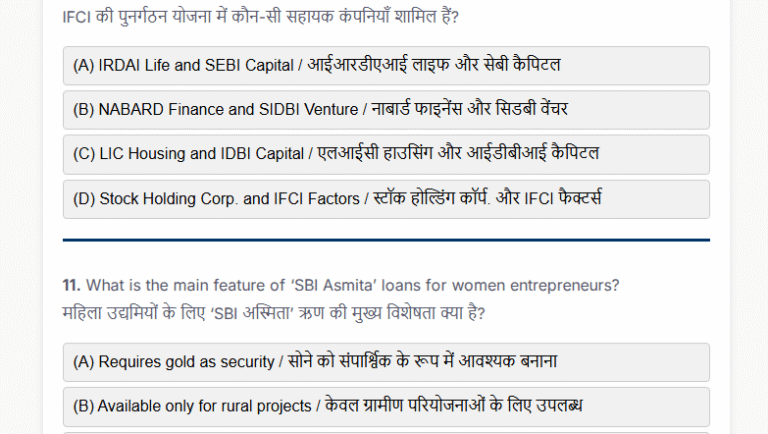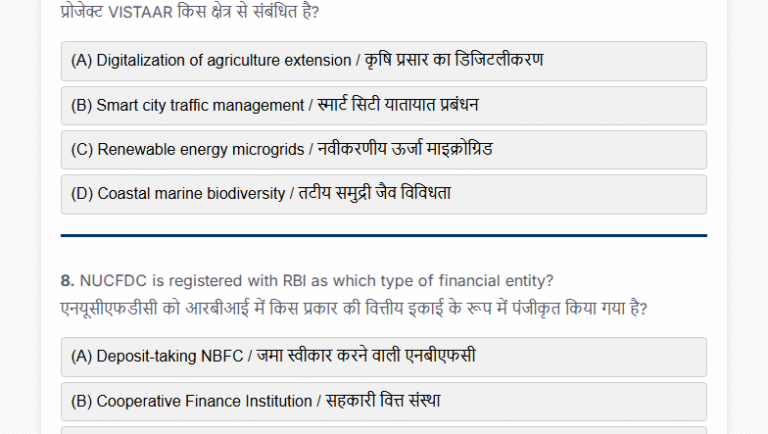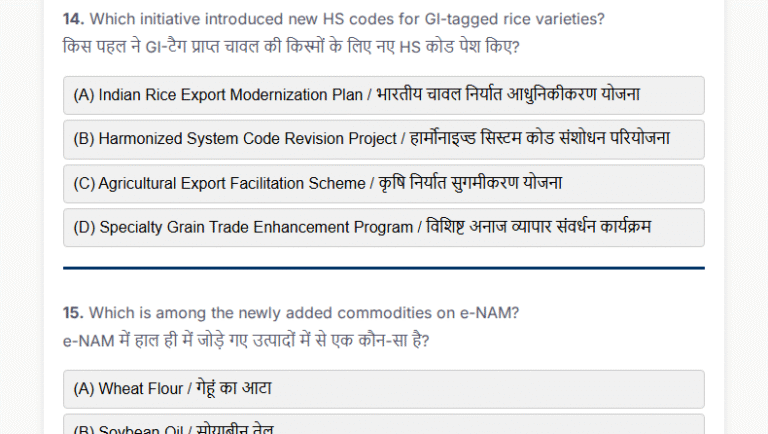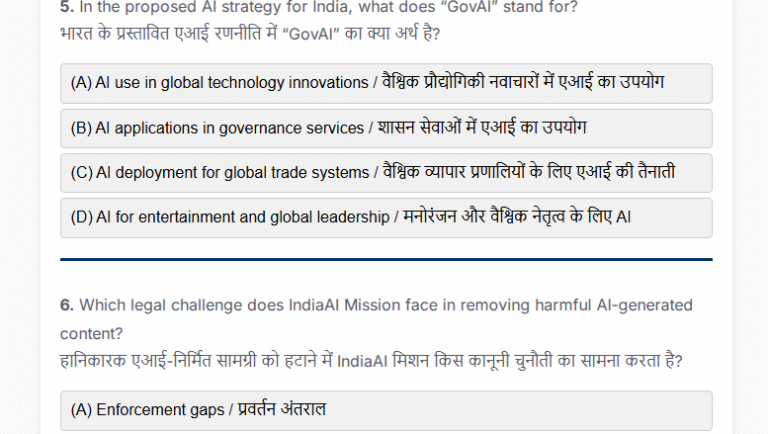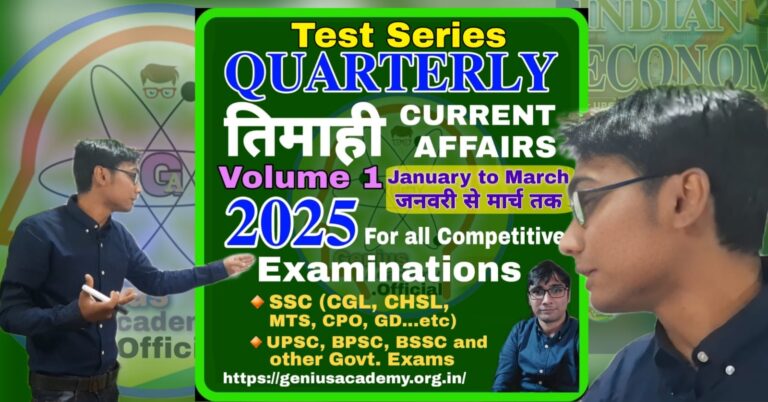Current Affairs Today MCQs (3 Nov 2024)
1. To whom was the Balfour Declaration addressed?
(A) David Ben-Gurion
(B) Chaim Weizmann
(C) Lionel Walter Rothschild
(D) Theodore Herzl
The correct answer is (C) Lionel Walter Rothschild
he Balfour Declaration was a letter written by British Foreign Secretary Arthur Balfour on November 2, 1917, to Lionel Walter Rothschild, a prominent Anglo-Jewish community leader. It expressed British support for the establishment of a Jewish homeland in Palestine, marking a pivotal moment leading to the creation of Israel in 1948.
2. Which of the following was NOT a factor leading to the Balfour Declaration?
(A) Zionist Movement
(B) Industrialization in Palestine
(C) British strategic interests during World War I
(D) Support from Jewish communities in the U.S. and Russia
The correct answer is (B) Industrialization in Palestine
The Zionist Movement and British strategic interests during World War I, including gaining Jewish support in the U.S. and Russia, were key factors behind the Balfour Declaration. Industrialization in Palestine did not influence the decision.
3. Ningol Chakkouba is celebrated to strengthen relationships between which family members?
(A) Parents and sons
(B) Sisters and brothers
(C) Grandparents and grandchildren
(D) Cousins
The correct answer is (B) Sisters and brothers
Ningol Chakkouba, celebrated in Manipur, is a festival where married daughters (Ningols) are invited by their brothers for a feast. It symbolizes the strong bond between siblings and fosters familial affection.
4. During whose reign did Ningol Chakkouba originate?
(A) King Nongda Lairen Pakhangba
(B) King Garib Niwaz
(C) King Bhagyachandra
(D) King Chandrakirti
The correct answer is (A) King Nongda Lairen Pakhangba
The Ningol Chakkouba festival traces its origins to the reign of King Nongda Lairen Pakhangba of Manipur. It is traditionally celebrated on the second lunar day of the Hiyangei month.
5. What is the primary goal of the DICSC project?
(A) Promote digital literacy among urban youth
(B) Develop AI-driven governance systems
(C) Bridge the digital divide in rural India
(D) Establish a nationwide IT university
The correct answer is (C) Bridge the digital divide in rural India
The DICSC project, launched by the Ministry of Electronics and IT, aims to provide rural citizens with accessible e-governance, financial, and commercial services, thereby reducing the digital divide and promoting inclusivity.
6. Which of the following is NOT a service provided by DICSC?
(A) Aadhaar registration
(B) Tele-law services
(C) International banking solutions
(D) High-speed broadband connectivity
The correct answer is (C) International banking solutions
DICSC focuses on rural accessibility to services like Aadhaar registration, tele-law, and broadband connectivity. It does not provide international banking solutions, as its scope is limited to domestic governance services.
7. By which year does India aim to eliminate tuberculosis (TB)?
(A) 2023
(B) 2025
(C) 2030
(D) 2035
The correct answer is (B) 2025
India has set an ambitious goal to eliminate TB by 2025, five years ahead of the global target of 2030. This effort is supported by initiatives like the Ni-Kshay Poshan Yojana and the BPALM regimen for drug-resistant TB.
8. What does the Ni-Kshay Poshan Yojana aim to provide?
(A) Financial aid for medical expenses
(B) Free diagnostic tests for TB
(C) Awareness campaigns on TB
(D) Nutritional support to TB patients
The correct answer is (D) Nutritional support to TB patients
The Ni-Kshay Poshan Yojana is a government initiative offering nutritional support to tuberculosis patients, enhancing their recovery and reducing the disease’s impact on vulnerable populations.
9. What decline in TB incidence did WHO recognize for India from 2015 to 2023?
(A) 8.3%
(B) 10.5%
(C) 17.7%
(D) 20.2%
The correct answer is (C) 17.7%
WHO acknowledged India’s significant progress in reducing TB incidence by 17.7% from 2015 to 2023. This rate is over double the global average decline of 8.3%, reflecting the effectiveness of India’s TB elimination strategies.
10. Which event is closely linked to the Balfour Declaration?
(A) Creation of Israel in 1948
(B) Start of the Zionist Movement
(C) End of World War I
(D) Collapse of the Ottoman Empire
The correct answer is (A) Creation of Israel in 1948
The Balfour Declaration of 1917 laid the groundwork for the establishment of a Jewish homeland in Palestine. This culminated in the creation of Israel in 1948, shaping the geopolitical dynamics of the region.
11. How did the Balfour Declaration serve British strategic interests during World War I?
(A) By ensuring economic alliances with Arab nations
(B) By garnering support from Jewish communities in the U.S. and Russia
(C) By establishing Palestine as a British colony
(D) By ending Ottoman control in Europe
The correct answer is (B) By garnering support from Jewish communities in the U.S. and Russia
The Balfour Declaration was strategically aligned with British interests during World War I. By supporting the Zionist goal for a homeland in Palestine, Britain sought to gain the backing of influential Jewish communities in the U.S. and Russia, key allies in the war effort.
12. Which community originally celebrated Ningol Chakkouba in Manipur?
(A) Naga
(B) Kuki
(C) Pangal
(D) Meitei
The correct answer is (D) Meitei
Ningol Chakkouba was originally celebrated by the Meitei community of Manipur. Over time, its cultural significance has extended to other communities, making it a symbol of unity and familial bonds in the region.
13. Which organization oversees the implementation of the Digital India Common Service Centre (DICSC) project?
(A) NIC (National Informatics Centre)
(B) Common Services Centres e-Governance Services India Limited
(C) Ministry of Rural Development
(D) Digital India Corporation
The correct answer is (B) Common Services Centres e-Governance Services India Limited
The implementation of the DICSC project is managed by Common Services Centres e-Governance Services India Limited. This organization focuses on providing rural citizens with access to essential digital services like Aadhaar registration and banking.
14. What triggers the implementation of Stage 2 measures in the Graded Response Action Plan (GRAP) for Delhi-NCR?
(A) AQI between 100 and 200
(B) AQI between 201 and 300
(C) AQI between 301 and 400
(D) AQI above 400
The correct answer is (C) AQI between 301 and 400
The Graded Response Action Plan (GRAP) is activated in stages based on the Air Quality Index (AQI). Stage 2 measures are implemented when the AQI reaches the “very poor” category, i.e., between 301 and 400, to reduce air pollution levels effectively.
15. Why is the Ni-Kshay Poshan Yojana important in TB elimination efforts?
(A) It provides cash incentives for early diagnosis of TB
(B) It supports the nutritional needs of TB patients
(C) It funds research on new TB treatments.
(D) It helps establish TB-free zones in urban areas
The correct answer is (B) It supports the nutritional needs of TB patients
The Ni-Kshay Poshan Yojana provides direct nutritional support to tuberculosis patients, ensuring they receive adequate dietary requirements during treatment. This improves patient outcomes and aligns with India’s goal of eliminating TB by 2025.
16. What was the main aim of the Zionist Movement that influenced the Balfour Declaration?
(A) Creating a Jewish homeland in Palestine
(B) Establishing a global financial system
(C) Rebuilding the Ottoman Empire
(D) Uniting Jewish and Arab communities
The correct answer is (A) Creating a Jewish homeland in Palestine
The Zionist Movement aimed to establish a homeland for Jews in Palestine as a refuge from persecution. The Balfour Declaration marked a key milestone, gaining British support for this cause and influencing future geopolitical developments.
17. What AQI range falls under the “poor” category?
(A) 0-50
(B) 51-100
(C) 101-200
(D) 201-300
The correct answer is (D) 201-300
The Air Quality Index (AQI) categorizes pollution levels into six bands. A score between 201-300 is classified as “poor,” indicating potential health risks, especially for sensitive groups like children and the elderly.
18. When and where was the first edition of Exercise GARUD SHAKTI conducted?
(A) 2005 in Indonesia
(B) 2008 in India
(C) 2012 in India
(D) 2015 in Indonesia
The correct answer is (C) 2012 in India
Exercise GARUD SHAKTI, a joint special forces exercise between India and Indonesia, was first conducted in 2012 in India. It aims to enhance cooperation and interoperability between the two nations’ armed forces.
19. Why is PM 2.5 considered more dangerous than PM 10?
(A) It contains radioactive particles
(B) It enters the lungs and bloodstream more easily
(C) It has higher levels of heavy metals
(D) It blocks sunlight effectively
The correct answer is (B) It enters the lungs and bloodstream more easily
PM 2.5 particles are smaller than PM 10, allowing them to penetrate deep into the lungs and even enter the bloodstream. Prolonged exposure can lead to severe respiratory and cardiovascular issues.
20. The Balfour Declaration is linked to which geopolitical development?
(A) The start of the Arab-Israeli conflict
(B) The dissolution of the Ottoman Empire
(C) The partition of British India
(D) The creation of NATO
The correct answer is (A) The start of the Arab-Israeli conflict
The Balfour Declaration supported the establishment of a Jewish homeland in Palestine, leading to tensions between Jews and Arabs in the region. This declaration is a precursor to the modern Arab-Israeli conflict.
_
Set 20 Quarterly CA 2025 Jan to March IMPORTANT INSTRUCTIONS This test consists of 25 questions.At…
Set 19 Quarterly CA 2025 Jan to March IMPORTANT INSTRUCTIONS This test consists of 25 questions.At…
Set 18 Quarterly CA 2025 Jan to March IMPORTANT INSTRUCTIONS This test consists of 25 questions.At…
Set 17 Quarterly CA 2025 Jan to March IMPORTANT INSTRUCTIONS This test consists of 25 questions.At…
Set 16 Quarterly CA 2025 Jan to March IMPORTANT INSTRUCTIONS This test consists of 25 questions.At…
Set 15 Quarterly CA 2025 Jan to March IMPORTANT INSTRUCTIONS This test consists of 25 questions.At…
Set 14 Quarterly CA 2025 Jan to March IMPORTANT INSTRUCTIONS This test consists of 25 questions.At…
Set 13 Quarterly CA 2025 Jan to March IMPORTANT INSTRUCTIONS This test consists of 25 questions.At…
Set 12 Quarterly CA 2025 Jan to March IMPORTANT INSTRUCTIONS This test consists of 25 questions.At…
Set 11 Quarterly CA 2025 Jan to March IMPORTANT INSTRUCTIONS This test consists of 25 questions.At…
Set 10 Quarterly CA 2025 Jan to March IMPORTANT INSTRUCTIONS This test consists of 25 questions.At…
Set 9 Quarterly CA 2025 Jan to March IMPORTANT INSTRUCTIONS This test consists of 25 questions.At…
Set 8 Quarterly CA 2025 Jan to March IMPORTANT INSTRUCTIONS This test consists of 25 questions.At…
Set 7 Quarterly CA 2025 Jan to March IMPORTANT INSTRUCTIONS This test consists of 25 questions.At…
Set 6 Quarterly CA 2025 Jan to March IMPORTANT INSTRUCTIONS This test consists of 25 questions.At…
Set 5 Quarterly CA 2025 Jan to March IMPORTANT INSTRUCTIONS This test consists of 25 questions.At…
Set 4 Quarterly CA 2025 Jan to March IMPORTANT INSTRUCTIONS This test consists of 25 questions.At…
Set 2 Quarterly CA 2025 Jan to March IMPORTANT INSTRUCTIONS This test consists of 25 questions.At…
Set 3 Quarterly CA 2025 Jan to March IMPORTANT INSTRUCTIONS This test consists of 25 questions.At…
Test Series of 1st Quarterly Current Affairs 2025 प्रथम त्रैमासिक करेंट अफेयर्स 2025 की टेस्ट सीरीज़…
Current Affairs Today MCQs (26 Nov 2024) 1. What is the primary purpose of the Rejang Dewa dance in…
Current Affairs Today MCQs (25 Nov 2024) 1. What feature distinguishes African penguins from other…
Current Affairs Today MCQs (24 Nov 2024) 1. Which of the following is a distinctive feature of…
Current Affairs Today MCQs (23 Nov 2024) 1. What is the target adaptation finance commitment for the…
Current Affairs Today MCQs (22 Nov 2024) 1. How many youth are targeted for internships under the PM…
Current Affairs Today MCQs (21 Nov 2024) 1. Which is the funding ratio for PM-JAY between the Centre…
Current Affairs Today MCQs (20 Nov 2024) 1. Who is eligible for the Ayushman Vay Vandana Card? (A)…
Current Affairs Today MCQs (5 Nov 2024) 1. What conditions contribute to the formation of the DANA…
Current Affairs Today MCQs (4 Nov 2024) 1. What is the primary function of Israel’s Iron Beam…
Current Affairs Today MCQs (19 Nov 2024) 1. What is the name of Nigeria’s second highest national…

